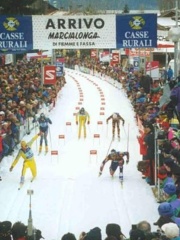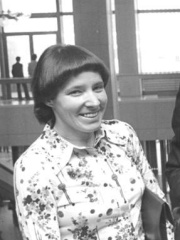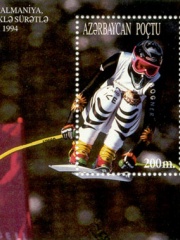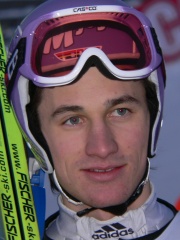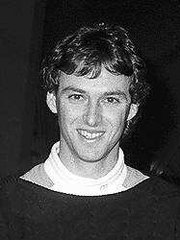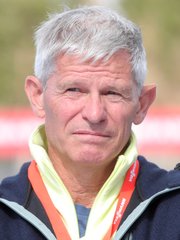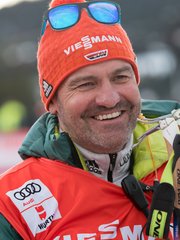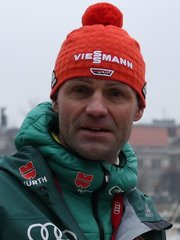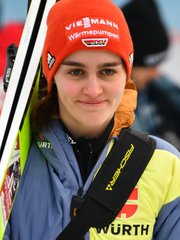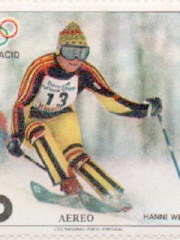

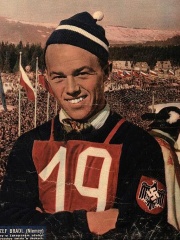
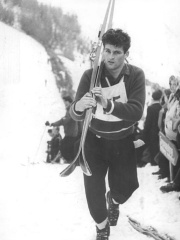
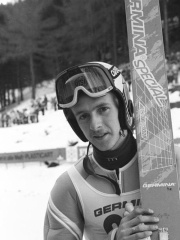
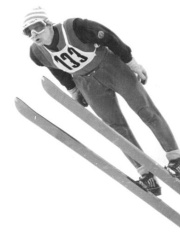

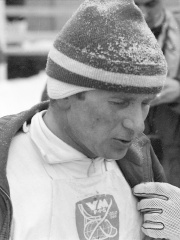
The Most Famous
SKIERS from Germany
Top 10
The following people are considered by Pantheon to be the top 10 most legendary German Skiers of all time. This list of famous German Skiers is sorted by HPI (Historical Popularity Index), a metric that aggregates information on a biography's online popularity. Visit the rankings page to view the entire list of German Skiers.

1. Hanni Wenzel (b. 1956)
With an HPI of 59.46, Hanni Wenzel is the most famous German Skier. Her biography has been translated into 31 different languages on wikipedia.
Hannelore (Hanni) Wenzel (born 14 December 1956) is a retired Liechtensteiner alpine ski racer. Wenzel is a former Olympic, World Cup, and world champion. She won Liechtenstein's first-ever Olympic medal at the 1976 Winter Olympics in Innsbruck, Austria, and its first two Olympic gold medals four years later in Lake Placid, New York.

2. Rosi Mittermaier (1950 - 2023)
With an HPI of 57.30, Rosi Mittermaier is the 2nd most famous German Skier. Her biography has been translated into 33 different languages.
Rosa Anna Katharina Mittermaier-Neureuther (German: [ˈʁozi ˈmɪtɐˌmaɪ̯ɐ] ; née Mittermaier; 5 August 1950 – 4 January 2023) was a German alpine skier. She was the overall World Cup champion in 1976 and a double gold medalist at the 1976 Winter Olympics. Mittermaier competed in alpine skiing from 1967 to 1976, retiring after a highly successful season in which she finished with two Olympic gold medals and ranked first in the World Cup. She remained popular, advertising for sports and as a non-fiction writer. She was known as Gold-Rosi, and she was inducted into Germany's Sports Hall of Fame in April 2006 when it was initiated.

3. Josef Bradl (1918 - 1982)
With an HPI of 57.01, Josef Bradl is the 3rd most famous German Skier. His biography has been translated into 17 different languages.
Josef "Sepp" / "Bubi" Bradl (8 January 1918 – 3 March 1982) was an Austrian ski jumper who competed during the 1930s and 1950s. He was born in Wasserburg am Inn, Bavaria.

4. Helmut Recknagel (b. 1937)
With an HPI of 56.37, Helmut Recknagel is the 4th most famous German Skier. His biography has been translated into 21 different languages.
Helmut Recknagel (born 20 March 1937 in Steinbach-Hallenberg) is an East German former ski jumper who was active in the late 1950s and early 1960s. He earned a gold medal at the 1960 Winter Olympics in ski jumping and also won the Holmenkollen ski festival ski jumping competition twice (1957 and 1960). Recknagel was the first non-Skandinavian to have won the traditional contest. At the FIS Nordic World Ski Championships, he won three medals: a bronze in 1958 and two medals in 1962, a gold in the individual large hill and a bronze in the individual normal hill. For his ski jumping efforts, Recknagel was awarded the Holmenkollen medal in 1960 (shared with Sixten Jernberg, Sverre Stensheim, and Tormod Knutsen). He was the first German to win the award. Recknagel was furthermore the first athlete to have won the Four Hills Tournament three times and the first to have won five single competitions at this event. After the end of his career, Recknagel, who was originally a tool and die maker, studied veterinary medicine and obtained one's doctorate in 1973. From 1974 until the end of the GDR he worked in public administration as a veterinarian and controller of hygiene and food. In 1996 Recknagel found a company for assistive technology in Berlin.
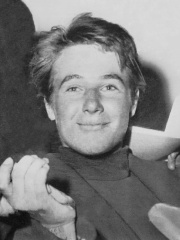
5. Heidi Biebl (1941 - 2022)
With an HPI of 54.93, Heidi Biebl is the 5th most famous German Skier. Her biography has been translated into 23 different languages.
Heidi Biebl (17 February 1941 – 20 January 2022) was a German alpine skier.

6. Jens Weißflog (b. 1964)
With an HPI of 54.79, Jens Weißflog is the 6th most famous German Skier. His biography has been translated into 33 different languages.
Jens Weißflog (German pronunciation: [jɛns ˈvaɪsfloːk] ; born 21 July 1964) is an East German and later German former ski jumper. He is one of the best and most successful ski jumpers in the history of the sport. He is a two time olympic and nordic world ski champion; also overall world winner.

7. Hans-Georg Aschenbach (b. 1951)
With an HPI of 54.64, Hans-Georg Aschenbach is the 7th most famous German Skier. His biography has been translated into 21 different languages.
Hans-Georg Aschenbach (born 20 October 1951) is a former East German ski jumper. In 1969 he became junior world champion, and two years later won his first national title. He won the FIS Ski Flying World Championships in 1973. In 1974 he won the Four Hills Tournament, and both ski jumping events at the FIS Nordic World Ski Championships in Falun. Owing to these achievements he was named the East German sportspersonality of the year. He sat out most of 1975 due to a knee injury, but recovered by the 1976 Winter Olympics, where he took the gold medal in the individual normal hill event. Aschenbach retired right after the Olympics to work as a military and sports doctor. In 1988, while serving as the physician of the East German ski jumping team, he defected into West Germany, where he worked as an orthopedic surgeon.

8. Franz Pfnür (1908 - 1996)
With an HPI of 54.07, Franz Pfnür is the 8th most famous German Skier. His biography has been translated into 16 different languages.
Franz Pfnür (21 November 1908 – 21 September 1996) was a German alpine skier who competed in the 1936 Winter Olympics. He was born in Schellenberg. In 1936, he won the gold medal in the alpine skiing combined event. As a recognition of his achievements, Pfnür was later invited to coffee with Adolf Hitler at his mountain retreat in Obersalzberg. He also joined the Schutzstaffel (SS).

9. Georg Thoma (b. 1937)
With an HPI of 53.64, Georg Thoma is the 9th most famous German Skier. His biography has been translated into 20 different languages.
Georg Thoma, (German pronunciation: [ˈɡeːɔʁk ˈtoːmaː] ) born 20 August 1937, is a retired German Nordic combined skier and ski jumper. He won a gold medal at the 1960 Olympics, becoming the first non-Scandinavian athlete to do so, and was voted German Sportsman of the Year. At the 1964 Olympics, he won a bronze medal and served as the Olympic flag bearer for Germany at the opening ceremony. He then won the world championships title in 1966. Thoma's strength in the Nordic combined was jumping. He was three times German champion in ski jumping (1960, 1961, and 1963). Additionally, he won the Nordic combined at the Holmenkollen ski festival from 1963 to 1966. For his Nordic combined successes, Thoma was awarded the Holmenkollen medal in 1964 (ahared with Veikko Kankkonen, Eero Mäntyranta, and Halvor Næs). Thoma is the uncle of the ski jumper Dieter Thoma. After retiring from competitions he worked as a postman in his hometown, and later as a television commentator. He was one of the first German winter athletes to make his living from sponsorship.
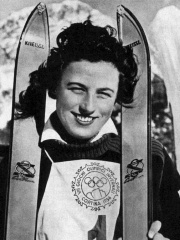
10. Ossi Reichert (1925 - 2006)
With an HPI of 53.34, Ossi Reichert is the 10th most famous German Skier. Her biography has been translated into 19 different languages.
Rosa "Ossi" Reichert (25 December 1925 – 16 July 2006) was a German alpine skier. Her greatest victory was in the 1956 Winter Olympics giant slalom at Cortina d'Ampezzo, Germany's sole gold medal at these games (and Germany's first gold medal in Olympics after the Second World War). After having seriously injured an ankle in 1954, she was not expected to do well at these games. She also drew the #1 start position for the one-run event. Josefa „Putzi“ Frandl, who won the silver medal in the event, once stated that, "Ossi was disappointed to draw #1 as that was usually not a good position. The first racer down the course usually has to scrape off a bit of snow, which slows you down. But Ossi had a great run and overcame that difficulty." Reichert also participated in the 1952 Winter Olympics in Oslo, where she won a silver medal in the slalom, beating her fellow German Annemarie Buchner for the bronze medal. Domestically Reichert won three German titles in 1956, in the slalom, giant slalom and combined events. She retired the same year to run the hotel of her parents in her home town the Allgäu region.
People
Pantheon has 92 people classified as German skiers born between 1908 and 2001. Of these 92, 86 (93.48%) of them are still alive today. The most famous living German skiers include Hanni Wenzel, Helmut Recknagel, and Jens Weißflog. The most famous deceased German skiers include Rosi Mittermaier, Josef Bradl, and Heidi Biebl. As of April 2024, 17 new German skiers have been added to Pantheon including Carola Anding, Thomas Müller, and Hubert Schwarz.
Living German Skiers
Go to all RankingsHanni Wenzel
1956 - Present
HPI: 59.46
Helmut Recknagel
1937 - Present
HPI: 56.37
Jens Weißflog
1964 - Present
HPI: 54.79
Hans-Georg Aschenbach
1951 - Present
HPI: 54.64
Georg Thoma
1937 - Present
HPI: 53.64
Johann Mühlegg
1970 - Present
HPI: 53.03
Barbara Petzold
1955 - Present
HPI: 52.42
Sven Hannawald
1974 - Present
HPI: 50.45
Veronika Schmidt
1952 - Present
HPI: 50.39
Katja Seizinger
1972 - Present
HPI: 50.10
Jochen Danneberg
1953 - Present
HPI: 49.61
Martin Schmitt
1978 - Present
HPI: 49.51
Deceased German Skiers
Go to all RankingsRosi Mittermaier
1950 - 2023
HPI: 57.30
Josef Bradl
1918 - 1982
HPI: 57.01
Heidi Biebl
1941 - 2022
HPI: 54.93
Franz Pfnür
1908 - 1996
HPI: 54.07
Ossi Reichert
1925 - 2006
HPI: 53.34
Annemarie Buchner
1924 - 2014
HPI: 52.36
Newly Added German Skiers (2025)
Go to all RankingsCarola Anding
1960 - Present
HPI: 48.98
Thomas Müller
1961 - Present
HPI: 48.57
Hubert Schwarz
1960 - Present
HPI: 45.77
Hermann Weinbuch
1960 - Present
HPI: 44.81
Andreas Schlütter
1972 - Present
HPI: 41.24
Simone Greiner-Petter-Memm
1967 - Present
HPI: 41.17
Pius Paschke
1990 - Present
HPI: 34.49
Anna Schaffelhuber
1993 - Present
HPI: 33.78
Pascal Bodmer
1991 - Present
HPI: 33.13
Juliane Seyfarth
1990 - Present
HPI: 33.11
Selina Freitag
2001 - Present
HPI: 32.60
Ramona Straub
1993 - Present
HPI: 31.80
Overlapping Lives
Which Skiers were alive at the same time? This visualization shows the lifespans of the 5 most globally memorable Skiers since 1700.

